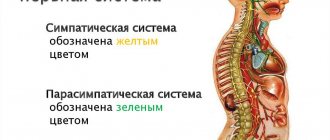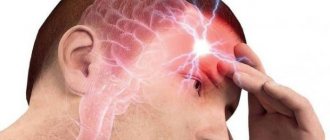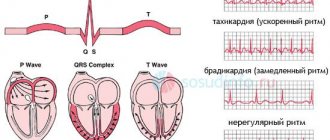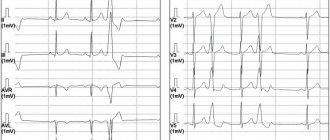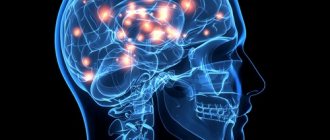Soviet myth about vegetative-vascular dystonia
Due to the lack of direct access to a database of sources of evidence-based medicine in the USSR, the diagnosis “vegetative-vascular dystonia” was born, which doctors (usually of the old school) still give right and left to people aged 12 to 60 years. But in not a single developed country in the world is there a doctor who would give a patient such a diagnosis. It simply doesn't exist.
The diagnosis of VSD is a rudiment of Soviet medicine in the modern world, which rather indicates that the doctor does not understand the real causes of the ailment.
At the moment, the closest real-life disease to the diagnosis of VSD is somatoform dysfunction of the autonomic nervous system. This disease is dealt with by a psychiatrist and a neurologist, and often a psychologist is also involved for supportive therapy.
There is not and has never existed any research method that could confirm the diagnosis of “vegetative-vascular dystonia”. This is not a disease, but rather a condition of the body, which indicates the need to search for the real cause of the ailment.
Vegetovascular dystonia and panic attacks
A person who has experienced a panic attack will forever remember the feeling of overwhelming, unconscious fear. It evaporates as incredibly quickly as it appears. This anxiety is not inspired by the outside world, and irritability is not the outcome of the problems that have piled up. The patient experiences characteristic symptoms in the form of rapid heartbeat, breathing discomfort and tremors. The body seems to have received a dose of adrenaline, as panic begins from an inexplicable condition.
People say they feel their own death approaching and their minds clouded. Internal organs react sharply to the condition, causing chills, vomiting and fever. Patients rarely realize that they have become a victim of a panic attack. Due to VSD, the situation may repeat itself again and again until action is taken.
How is a panic attack related to VSD?
The human body is a single network where each internal organ is coordinated in one way or another with another. This rule does not bypass the nervous system, which is associated with VSD disease. According to researchers, this happens due to the constriction of blood vessels, which quickly deliver stimulation to the nervous system. A sharp jump in pressure creates the effect of a state of panic. There are explanations in psychoanalytic reasons, as well as in genetics. It is a clear fact that the disease passes from parent to child in ninety-five cases out of a hundred. As for mental disorders, in general, everything depends on the emotional instability of the person.
What are the reasons for panic attacks and how to avoid them?
From childhood, we are instilled with a love for a healthy lifestyle. Constant physical activity is a vaccine against diseases, especially nervous diseases. It is necessary to drive away negative thoughts, filling them with fitness, walks and all kinds of trips. It is the lack of physical activity and dependence on substances such as nicotine and caffeine that slowly but surely leads the body to an accumulation of tension.
How are panic attacks treated with vegetative-vascular dystonia?
If a patient experiences groundless panic, containing a number of the above symptoms, then doctors advise not to aggravate the process with medications in large quantities. Treatment of vegetative-vascular dystonia begins with sedatives - validol and corvalol. In this case, the use of an abundance of pharmaceutical drugs will not eliminate the disease in which neuroses worsen, but will turn into another bad habit. Tranquilizers and antidepressants are in demand, taking the patient out of negativity and creating a feeling of peace. Such medications have a small chance of getting rid of the disease with individual manifestations. But none of them is a surefire way to kill a panic attack with pronounced symptoms.
One of the best methods of coping is to make an appointment with a psychotherapist. The goal of the doctor is to influence the connection between the environment, personal experiences and the patient. If necessary, psychotherapy is used together with prescribed pills for neurosis. In addition, you need to independently learn relaxation in order to apply the methods during the next crisis.
Self-help for panic attacks
As mentioned earlier, a hypertensive crisis dramatically disarms a person, appearing at any moment of the day or night.
During the next attack, you cannot rely on your family and the ambulance team. You need to realize that if you don’t help yourself, your chances of getting back to normal are reduced. In such cases, instructions on proper breathing are used, since the next wave completely disrupts the heart rhythm. The supply of oxygen through four breaths per minute normalizes the heartbeat. The patient must understand that his tense state will subside in the near future. Manipulate your consciousness. Author: K.M.N., Academician of the Russian Academy of Medical Sciences M.A. Bobyr
Symptoms of VSD
Symptoms of so-called vegetative-vascular dystonia include:
- Dizziness
- Headache
- Intercostal neuralgia
- Heartbeat disturbance
- Numbness and coldness of the extremities
- Unexplained pain in different parts of the body
- Pale skin
- Low or high blood pressure
- Anxiety, panic attacks
- Lack of air
- Sweating
- Trembling in the body
- Sleep disturbance
- General weakness
- Fainting
In some cases, patients complain of digestive disorders - diarrhea, flatulence, discomfort in the intestinal area.
That is, the patient may be bothered by 2 to 10 symptoms, which can be difficult to connect with each other and understand “what actually hurts me.” A person comes to the doctor in confusion, and sometimes in panic, thinking that he is overcome by an unknown disease.
Restoring normal life
It will consist not only of nutrition, exercise and the elimination of provoking factors. It is important that the patient monitors his health, avoids stressful situations, gets good sleep and avoids excessive stress. When the original cause has already been eliminated, a lot will depend on the person himself - his desire to get rid of the symptom and return to normal life.
As solutions that will help the patient establish the desired lifestyle, the Kuntsevo Medical and Rehabilitation Center offers physical therapy, physiotherapy, and massage. Many of the procedures are aimed not only at a specific problem, but also at increasing the level of happiness hormones - and this is important when treating panic attacks.
Diseases that are hidden under the diagnosis of VSD
What conclusions can be drawn from the previous block of the article?
Conclusion No. 1.
If you find yourself with the above symptoms, do not panic and consult a doctor in a timely manner. Because the disease will not disappear on its own, and you need to understand the reasons.
Conclusion No. 2.
Vegetative-vascular dystonia is a pseudo-diagnosis that hides a number of real diseases, which very often remain without proper treatment. Most often these are mental, neurological, endocrinological and cardiac disorders, which include:
- Anxiety and panic disorder
- Hypochondriacal disorder (this is worth paying attention to for patients who have been visiting doctors for years, taking tests and undergoing procedures that do not reveal any somatic diseases)
- Depression
- Migraine
- Hypo- and hyperthyroidism
- Hypertension
- Irritable bowel syndrome
- Cardiac ischemia
- Fibromyalgia (chronic pain syndrome)
- Asthma
How to identify the real cause of illness
If the doctor you consulted diagnosed you with VSD and did not prescribe any additional examinations, consult another specialist. In most cases, a neurologist and a psychiatrist can understand the real causes of VSD symptoms.
There is no need to be afraid of a psychiatrist. You are not included in any register, are not registered and are not classified as a group of people with severe mental disorders. People with depression, increased anxiety, panic attacks, and sleep disorders (for example, insomnia) turn to a psychiatrist. And in all these cases, the doctor can really provide qualified assistance.
A psychiatrist, neurologist or cardiologist will prescribe the following diagnostic procedures for you
:
- Clinical analysis of blood and urine
- Blood chemistry
- ECG or EchoCG
- Chest X-ray
- Ultrasound of the abdominal cavity (for complaints of pain and discomfort in the gastrointestinal tract)
- MRI of the brain and EEG (for complaints of headaches and dizziness)
After evaluating the research results, the doctor may refer you to a gastroenterologist or endocrinologist. This means that the real cause of your malaise lies in a gastrointestinal disease or hormonal imbalance.
Derealization in VSD
VSD and mental disorders can manifest themselves against the background of mental trauma, strong experiences and physical and nervous exhaustion. Some patients with VSD develop signs of mental disorders that do not allow them to lead a full life.
The feeling of unreality of what is happening during VSD or derealization is the brain’s reaction to stress. With this disorder, a person perceives the world around him as distant and unreal.
This disorder is different from panic attacks. The main signs of derealization are:
- perception of reality as unreal;
- changes in the perception of sounds, colors;
- feeling of weakness;
- increased blood pressure;
- fear of madness.
Against the background of these symptoms, the patient maintains adequate behavior and controls his actions. If signs of derealization appear, you must immediately consult your doctor who will prescribe treatment.
When treating derealization, it is necessary to get rid of bad habits and optimize time for rest and work. At the Yusupov Hospital, experienced psychotherapists interact with patients who have a feeling of unreality of what is happening with VSD, who use safe methods to eliminate depression and other manifestations of the disorder.
What will not help with the diagnosis of VSD
Very often, after vegetative-vascular dystonia is diagnosed, the local therapist sends the patient to drink vitamins, nootropics, nicotinic acid and motherwort. But there are two dangers in this:
- The patient was not properly examined, and the real disease remained in the shadow of the symptoms of VSD.
- Vitamins, nootropics and mild sedatives often work as a placebo, relieving symptoms only for a while - 1-3 months, after which everything returns to normal.
Does psychotherapy help with VSD?
A psychotherapist for VSD affects the psycho-emotional sphere using various methods. In most cases, after treatment for neuroses and psychological disorders associated with VSD, complete recovery occurs. During sessions, psychotherapists teach techniques to curb the manifestation of derealization and agoraphobia.
Psychotherapists use structured techniques to help relieve the patient from the manifestation of these disorders. During sessions, the patient can trust the specialist and talk about his experiences. If you need advice from a psychotherapist or other clinic specialists on the treatment and diagnosis of VSD and its manifestations, make an appointment by calling the Yusupov Hospital.
What will help with the diagnosis of VSD
Have you passed all the necessary examinations and have not found any somatic diseases? In this case, we are talking about a neurotic condition that could develop as a result of stress or excessive fatigue of the body and psyche. In fact, you are healthy, but you need to stabilize your psyche and help yourself recover.
What methods would be appropriate
:
- Visiting a psychologist and psychiatrist to monitor dynamics
- Organized work and rest schedule
- Healthy sleep pattern - at least 7-8 hours
- A healthy diet that includes a large amount of vegetables and fruits, vegetable fats (oils, nuts), fish and seafood, cereals, lean meats, dairy products.
- Moderate sports activities - walking, yoga, stretching, exercise therapy
- Relaxation techniques - meditation, taking a warm bath with sea salt and aromatic oils
- Reduced overall stress levels
